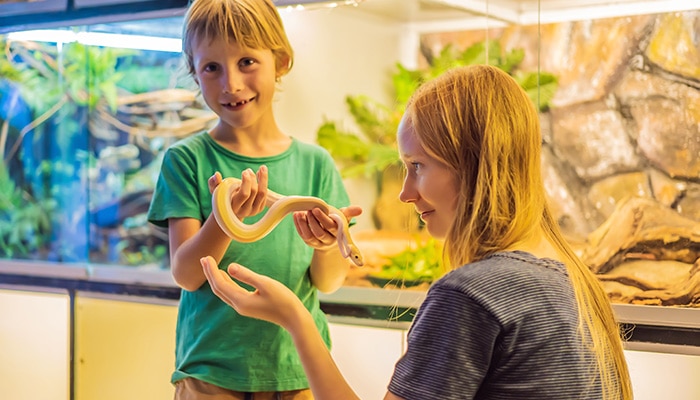While we believe that the books and resources recommended may be of value to you, keep in mind that these are suggestions only and you must do your own due diligence to determine whether the materials are appropriate and suitable for your use. PNC has no sponsorship or endorsement agreement with the authors or publishers of the materials listed.
ANIMAL FRIENDS

Fur, Feathers & Scales
Children will explore different kinds of animal coverings.

Lesson Objective
The children will explore different animal skin coverings and compare them to their own skin.
Science
What You'll Need
- Pictures of animals with skin coverings that match the samples below (see Lesson Tips)
- Pieces of furry, animal-print fabrics such as zebra, leopard, tiger, and so on (available inexpensively at fabric stores) – 1 small square per child
- Feathers (real or craft) – 1 per child
- Faux leather (available inexpensively at fabric stores) – 1 small square per child
- Faux reptile skin (available inexpensively at fabric stores) – 1 small square per child
What To Do
- Point to your skin, and ask the children what the stuff that is covering your body (“skin”) is called.
- Explain that skin is a protective covering for our bodies. Hair on our bodies also helps protect us.
- Ask the children whether they know of any other living thing that is covered with skin.
- Tell the children that they will be comparing different coverings on animal bodies.
- Display the animal-print fabrics, feathers, leather, and reptile skin.
- Choose one of the fabrics, and ask the children to describe what they might know about this animal skin; repeat for the other skin coverings.
- Distribute the fabric samples to the children.
- Ask the children to describe how the skin/fur/feather feels.
- Have the children describe how the animal fabric is different from their skin.
- Discuss how animal skins are helpful to animals (see Did You Know).
Resources
Home School Resources
Home educators: use these printable lesson PDFs to teach this lesson to your home schoolers. They're available in English and Spanish.
Content Provided By
Common Core State Standards Initiative – These lessons are aligned with the Common Core State Standards ("CCSS"). The CCSS provide a consistent, clear understanding of the concepts and skills children are expected to learn and guide teachers to provide their students with opportunities to gain these important skills and foundational knowledge [1]. Visit the CCSS


